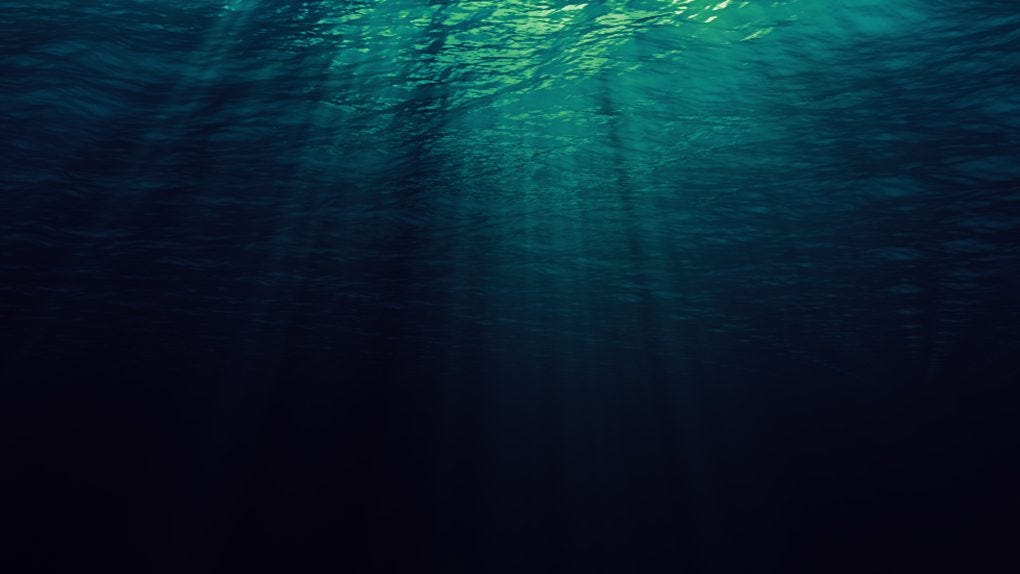Chris Erickson | February 11, 2025
The Whale Fall Edition
On depth, death, and deep sea ecosystems.
Chris Erickson (CE) has done a few things, some of which were awesome but most of which were/are mundane.
Chris here. The ocean, that endless, suffocating abyss, is a place where things go to die. Slowly. Relentlessly. It’s a place where every living thing is just marking time until the inevitable takes it down into the black, crushing depths. You know this. It’s practically a cliche by now—everyone knows the ocean is a killer. But here’s the thing no one tells you: Death doesn’t end at the bottom. No. That’s when the real show starts. And it starts with the whale fall.
A whale, the lumbering, majestic, impossibly large creature that’s been roaming the seas like some kind of ancient god, isn’t just going to quietly decompose and sink into nothing when its life comes to an end. It’s too big for that. Too full of stories and secrets to let its carcass fade into oblivion. Instead, it goes down in style. When it dies, the beast plummets into the depths of the ocean, sinking slowly, like a bloated monument to decay.
And the moment it hits the seafloor? The clock starts ticking. And that’s when the chaos begins.
Why is this interesting?
Deep in the abyss, the ocean floor tends to be a barren wasteland. Welcome to the world of the whale fall, a gruesome yet oddly poetic phenomenon that turns the demise of a whale into the foundation for a thriving deep-sea ecosystem.
Imagine this: A whale, after living a life as a giant of the seas, finally succumbs to the inevitable. Its massive body begins its slow descent to the ocean floor, like a sinking Titanic, but without any of the fanfare. Once it reaches the bottom, it’s not just a death. It’s an event. A feast.
The scavengers show up almost immediately: sharks, crabs, hagfish—creatures that live for the chaos of a carcass, tearing into the soft flesh, fighting for the best cuts. The scene is pure savagery, a full-on feeding frenzy. It’s ugly, it’s brutal, and it’s the first act in a long, bizarre show that will last years.
But here’s where things take a dark turn. Once the larger scavengers have had their fill and slink away, the real freak show begins. Enter the bacteria—the tiny, invisible monsters that feast not just on meat, but on the very bones of the whale. These bacteria break down the lipids, turn fat into sulfur, and create a chemical soup of nutrients. It’s the kind of deep-sea compost that makes life thrive where there shouldn’t be any. These microbes—unsung heroes of the underworld—are the key to what happens next.
As the bacteria get to work, the whale’s skeleton becomes a scaffold for a new world. That’s right: As the bones decay, they become the foundation for a thriving ecosystem that feels straight out of a horror movie. Think glowing tube worms, sprouting like alien plants from the ribcage, living off the sulfur and minerals. Think crabs, shrimp, and clams, all swarming in to feast on the remaining scraps. And for decades the carcass continues to give life, long after the whale is gone. Decades. Can you imagine that? A single whale, sunk to the bottom of the sea, becoming the foundation for a new world, a new existence, a new purpose. Life doesn’t stop at the surface. It doesn’t stop when we stop breathing. The ocean doesn’t care that we’re here for a minute and gone the next. The ocean simply keeps turning your corpse into something new. There’s no respect for your failure, your existential crisis, or your attempts to make sense of things. It just consumes, adapts, survives.
A single dead whale, sinking into the cold, dark silence, becomes a fully functioning ecosystem for thirty years. “We’ll keep this party going,” the ocean says, “No matter how much you wish we wouldn’t.
And that’s where the real lesson lies. In the deep ocean, where light never reaches and oxygen is scarce, life doesn’t need sunshine or greenery. It needs decay. It thrives on the rot, the breakdown, the transformation of death into something else. That’s the real miracle. A dead whale doesn’t just rot away; it becomes a hotel, a city for the creatures that would never survive in the surface world. It’s a reminder that nothing, not even death, is wasted in nature. Everything feeds something else.
In the end, whale falls teach us something deeply unsettling: Life is a cycle, one that doesn’t stop when the lights go out. It just keeps going, feeding on itself, building something new out of the wreckage. Whether we like it or not, we’re all part of that system from the moment we’re born. Because in nature, death isn’t a conclusion; it’s a resource. We’re all just food for the future. Welcome to the buffet. (CE)
